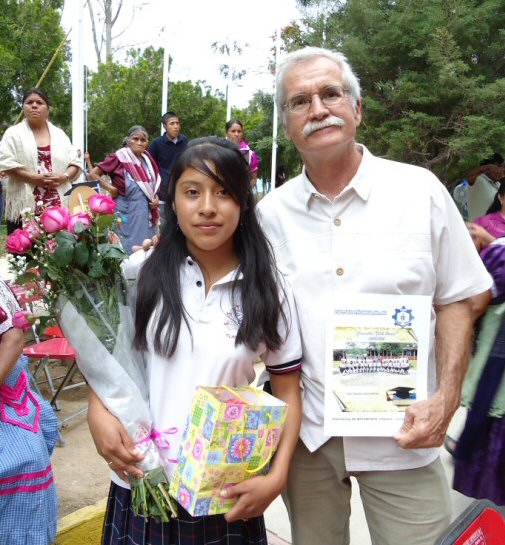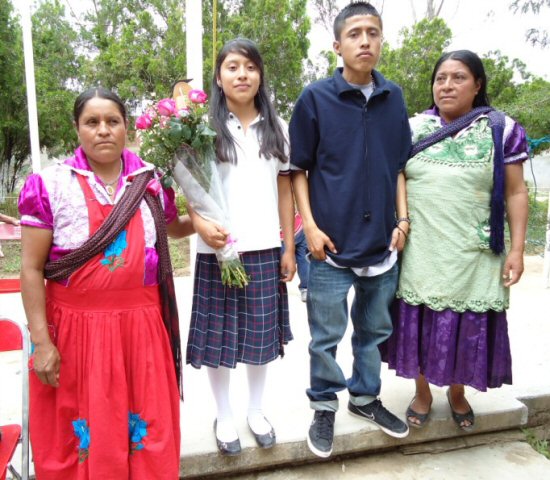
Proud Padrino with His Ahijada
|
Luci awoke at 5:30 a.m. to begin grinding corn to hand - make tortillas on a comal over an open flame. She wanted to make sure breakfast would be ready upon the arrival of her new padrinos (godparents). After all, it was to be one of the most important days in her still young life of 14 years. Her school headmaster had stressed that every graduate had to have a padrino.
Lucina Martina, Her Family and San Marcos Tlapazola in Context
Lucina Martina Cruz Aragón would be graduating from secondaria (junior high) later that morning, July 8, 2011, with a 9.4 grade point average. A soaring GPA is impressive enough, but in the southern Mexico state of Oaxaca, one of the poorest in the country, where public school education has been a hot and divisive issue for decades, it meant so much more for this particular graduate and her family. And it was probably just as important a rite of passage for the families of the other graduates, though perhaps not as significant.
 Proud Padrino with His Ahijada |
Luci lives with her mother, brother and aunt in the village of San Marcos Tlapazola, about an hour's drive from the city of Oaxaca, state capital, in the district of Tlacolula de Matamoros. The family, and indeed virtually everyone in the village, is bilingual - Spanish and Zapoteco.
For three years, day in and day out, Luci had been taking a colectivo (public transit) to get to and from Tlacolula to attend the Escuela Secundaria Técnica No. 48. But for Luci the ride was just part of her routine, much the same as juggling homework with her daily chores - helping the family to eke out a modest existence.
San Marcos Tlapazola has about 1,500 inhabitants, most of whom earn a living working the land and /or making red clay utilitarian pottery such as comales and bowls as well as more decorative dual function pieces serving the tourist trade. Many residents, including Luci, her mother María and aunt Gloria, sell the fruits of their labor at the Sunday Tlacolula market. María sells the pottery, Gloria offers her tejate, the refreshing, high nutrition pre - Hispanic drink, and Luci helps out with everything. She also sells her own clay figures, and earrings she hammers out of metal bottle caps with reproduced images of The Virgin, Day of the Dead, and Frida Kahlo.
Throughout the week Luci assists in the fields planting or harvesting corn, beans and squash, or simply weeding, as well as tending agave fields for nearby mezcal producers. She also accompanies María and Gloria into the hills to bring down clay for making their primitive pottery vessels. In her own right she has become adept at making a variety of figures, and in fact taught her mother and aunt how to make images of pre - Hispanic art, and incorporate them into their functional pieces.
But María and Gloria have always stressed that Luci's studies should be her top priority. Their counsel has now paid off.
More Than 200 Oaxacans Graduate to Fanfare, Anticipation from Family, Friends
Before leaving for Tlacolula, Luci, her family and her newly appointed padrinos share breakfast. The women serve the full fare customarily consumed at the beginning of important occasions in towns and villages flecking the central valleys of Oaxaca: mezcal to toast Salud, To health, Le chaim; frothy hot chocolate with small loaves of egg bread for dippers; mole negro; and of course Luci's fresh, hot, hand - made tortillas.
Shortly after 9 a.m., the appointed start time for the exercises, they all arrive at the school's open air makeshift auditorium, its plaza cívica. Shade is provided by a circus big - top style tarpaulin, fitting for this level of anticipation and excitement. The throngs of proud well - wishers continue to file in, most with floral bouquets or arrangements, some with other gifts. The pageantry is remarkable.
To an outsider from the US or Canada, it would be easy to mistake this small step forward in the lives of barely teenagers, for the graduation of a class of law, medical or accounting students. For some of the 227 graduates the challenge has been just as daunting. For most, and their families, it's a giant leap.
These are not the families with resources to send their children to private school and then off to out-of-state universities. There's nary a white face among the 2,000 odd people. Most are dressed like urban working class Oaxacans. But a large percentage of the women are wearing their traditional regional garb of hand - embroidered full size apron over a brightly colored ankle - length satin dress, the outfit typically encountered by visitors to the Tlacolula market on Sundays. It's what most women and their daughters wear on a daily basis in their home villages of San Bartolomé Quialana, San Lucas Quiavini, and of course San Marcos Tlapazola.
Within 20 minutes, every folding card table chair has been opened and occupied. Each student is in school uniform, officially a pre - requisite for even regular class attendance. Dignitaries representing the school administration, the state public education system, the teachers and their Section 22 union, and specially invited guests, are seated at a long adorned table on a platform at one end of the now covered concrete courtyard. The school band and marimbas are off to one side. The graduating class is seated adjacent, grouped into sections to facilitate the orderly calling each student to the podium.
Families, now settled into their chairs apart from their children, grandchildren, cousins, nieces and nephews, point and whisper while trying to find their graduates and those of fellow villagers seated across the plaza. But the alumni pay no attention, busy chattering with fellow classmates.
The din diminishes with the commencement of flag exercises mid court. The Mexican bandera is ceremoniously honored while every attendee pledge allegiance to it, and then to the constitution of the United States of Mexico. The singing of the Mexican national anthem is followed by playing the secondary school hymn. Each and every movement is taken just as seriously as when Canadians stand for the singing of O Canada before the start of a National Hockey League game - maybe more so.
In towns and villages throughout at least this part of Mexico, public school education is treated with respect, despite the constant conflict between union and government, and the polarization of the people from the teachers. Everyone has an opinion, a strong one at that, and is not afraid to express it. But in July, the month graduations take place in Tlacolula and indeed throughout virtually every town and village, politics are placed on the back burner. Graduating is far too important to be tarnished by distractions.
As the name of each graduate is called out, their supporters applaud, whistle and shout, as the pride of their lives walks to the podium to receive a personalized folder with a diploma noting GPA, together with a certificate of good conduct (a pre-requisite for graduating); an engraved glass memento; and a mug promoting a local furniture store.
A state authorized photographer and videographer have been in attendance, recording every moment. The former has also been taking stills of some graduates as they descend the podium to be presented with flowers and other gifts from family and padrinos. Of course almost everyone is toting a still or video camera, cellular phone or more sophisticated handheld electronic device. Luci's moment with her padrinos and family is similarly captured.
There's a break between each group's call to be honored; for speeches, to raffle off free - standing floor fans to a dozen graduates, to listen to the marimbas, and finally to watch a school dance troupe in full ceremonial dress perform a traditional Veracruzano dance.
Students who have already been called to receive their diplomas are entrusted with distributing to each guest seated in the auditorium, first a cup of nieve, sherbet flavored with fresh regional fruit, and then a luncheon plate with sandwich, canned soda and gelatin.
But before closing remarks, a number of students are recalled to the podium for special recognition of high academic achievement, those with GPAs from 9.5 to 10. Although Luci didn't make the grade, simply being there was enough for her, and everyone who knew her. Even neighbors who tend to be competitive and secretly jealous of one another, have always been quick to acknowledge that Luci is not only bright, but a valuable contributor to her family's well - being, both for her hard work and as a gifted artisan.
Preparatoria & Beyond, for Luci and Other Oaxacans with Similar Potential
En route back to the homestead in San Marcos Tlapazola, four hours after their arrival at the graduation, the family stops at the indoor market at Tlacolula for last minute purchases, for comida.
 Luci with her family |
It's approaching 2 p.m. and preparations are underway for yet another festive meal, this time barbacoa de res, beef prepared in an in - ground oven, served with all the trimmings, another village tradition for celebrating rites of passage; and more toasting.
Many more glasses will be raised over the next several years, honoring every step in Luci's educational pursuits. Next month she begins preparatoria, high school, though not in Tlacolula. She'll be attending a baccalaureate program in nearby Santa Ana del Valle. Yes, there are publicly funded high schools in Oaxaca with reputations for academic excellence. They are part of Mexico's baccalaureate curriculum. These schools are not subject to the work stoppages occasioned by Section 22 of the teachers' union.
Luci's excellent grades lead to her acceptance into the COBAO (El Colegio de Bachilleres de Oaxaca) program. Classes begin in August. But COBAO is expensive. There was already a fee to write the entrance exam, and now a much larger sum for the inscription is due; transportation to get to school in the more distant town will be more costly; Luci will have to buy lunch; she'll need money to pay for a new uniform, books and school supplies; and there will be additional incidentals on an ongoing basis.
Luci and her family are fortunate that her new padrinos, together with an American couple, have agreed to fund Luci's high school education in its entirety, and beyond.
While not every student with Luci's drive and potential is as fortunate, there are indeed programs available to provide both financial assistance and emotional support for promising students. They rely in part on tax deductible private donations. Grupo de Estudios Sobre la Mujer "Rosario Castellanos", and its scholarship program, Fonda de Becas "Guadalupe Musalem", (http://www.gesmujer.org) raises about $80,000 USD annually, to support 20 indigenous women in pursuit of higher education. Its track record is impressive. Since the mid 1990s the scholarship has been supported by internationally acclaimed singer Lila Downs, herself of Oaxacan heritage.
Luci's story is heartwarming. Those with a soft spot in their hearts for Mexico and its indigenous cultures, or for simply the pursuit of youth achieving their educational potential, should consider helping the other Lucis in rural Mexico, either directly or through a charitable educational foundation.
Alvin Starkman (M.A., LL.B.) has written over 200 articles about life and cultural traditions in Oaxaca and its central valleys. He is a paid Contributing Writer for Mexico Today, a program for Marca País - Imagen de México. Alvin operates Casa Machaya Oaxaca Bed & BreakfastCasa Machaya Oaxaca Bed & Breakfast with his wife Arlene, and Oaxaca Culinary Tours (http://www.oaxacaculinarytours.com) with internationally acclaimed chef Pilar Cabrera. Alvin is also a consultant to documentary film companies and photographers working in the region, and counsels tourists to Oaxaca in an effort to make their visit as culturally rich, rewarding and enjoyable as possible.